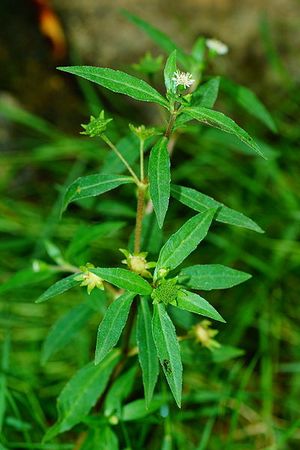Note: This is a project under development. The articles on this wiki are just being initiated and broadly incomplete. You can Help creating new pages.
Difference between revisions of "Eclipta prostrata - Bhrngaraja"
(→Flower) |
(→Fruit) |
||
| Line 26: | Line 26: | ||
===Fruit=== | ===Fruit=== | ||
| − | {{Fruit| | + | {{Fruit|oblong achene||An oblong achene, 3-quetrous, hairy above. Fruiting January onwards|| }} |
===Other features=== | ===Other features=== | ||
Revision as of 13:01, 13 April 2018
Eclipta prostrata commonly known as false daisy, yerba de tago, and bhringraj, is a species of plant in the sunflower family. It is widespread across much of the world.This plant has cylindrical, grayish roots. The solitary flower heads are 6–8 mm (0.24–0.31 in) in diameter, with white florets. The achenes are compressed and narrowly winged. This species grows commonly in moist places as a weed in warm temperate to tropical areas worldwide. It is widely distributed throughout India, Nepal,It is reported to improve hair growth and color. prostrata decreased the amount of time it took for hair to begin regrowing.
Contents
Uses
Loss of appetite, Asthma, Productive cough, Hyperlipidemia, Mild Hypertension, Intestinal worm, Jaundice, Piles, Abdominal pain.
Parts Used
Chemical Composition
Wedelolactone, Luteolin, Apigenin, Triterpenoids – Eclalbatin, alpha-amyrin, oleanolic acid, ursolic acid, Flavonoids – apigenin and luteolin, Wedelolactone,Echinocystic acid glycosides, β-Sitosterol, Daucosterol [1]
Common names
| Language | Common name |
|---|---|
| Kannada | Ajagara |
| Hindi | Bhringaraj, Kesharaj |
| Malayalam | Kannunni |
| Tamil | Karisilanganni, Kavanthakara |
| Telugu | Galagara |
| Marathi | NA |
| Gujarathi | NA |
| Punjabi | NA |
| Kashmiri | NA |
| Sanskrit | Bhringaraj |
| English | False Daisy, Trailing eclipta |
Habit
Identification
Leaf
| Kind | Shape | Feature |
|---|---|---|
| Simple | Lanceolate | Leaf Apex is Acute, Leaf Base is Cuneate and Leaf Margin is Serrate-dentate. |
.[2]
Flower
| Type | Size | Color and composition | Stamen | More information |
|---|---|---|---|---|
| bisexual | 2.5 cm long | white | 5-20 | In axillary or terminal 1-3 capitula; white. Flowering from December-May |
Fruit
| Type | Size | Mass | Appearance | Seeds | More information |
|---|---|---|---|---|---|
| oblong achene | An oblong achene, 3-quetrous, hairy above. Fruiting January onwards | {{{6}}} |
Other features
List of Ayurvedic medicine in which the herb is used
- Vishatinduka Taila as root juice extract
Where to get the saplings
Mode of Propagation
How to plant/cultivate
Requires a damp to wet soil and a position in some shade[3]
Commonly seen growing in areas
Photo Gallery
References
External Links
- Ayurvedic Herbs known to be helpful to treat Loss of appetite
- Ayurvedic Herbs known to be helpful to treat Asthma
- Ayurvedic Herbs known to be helpful to treat Productive cough
- Ayurvedic Herbs known to be helpful to treat Hyperlipidemia
- Ayurvedic Herbs known to be helpful to treat Mild Hypertension
- Ayurvedic Herbs known to be helpful to treat Intestinal worm
- Ayurvedic Herbs known to be helpful to treat Jaundice
- Ayurvedic Herbs known to be helpful to treat Piles
- Ayurvedic Herbs known to be helpful to treat Abdominal pain
- Herbs with young shoots used in medicine
- Herbs with Leaves used in medicine
- Herbs with common name in Kannada
- Herbs with common name in Hindi
- Herbs with common name in Malayalam
- Herbs with common name in Tamil
- Herbs with common name in Telugu
- Herbs with common name in Sanskrit
- Herbs with common name in English
- Habit - Annual plant
- Index of Plants which can be propagated by Seeds
- Herbs that are commonly seen in the region of poorly drained
- Herbs that are commonly seen in the region of wet areas
- Herbs



